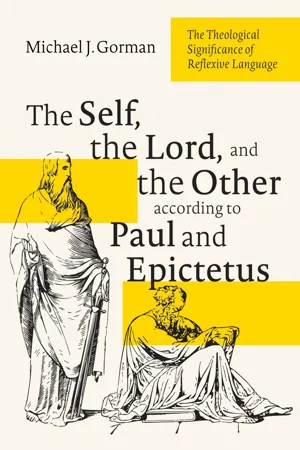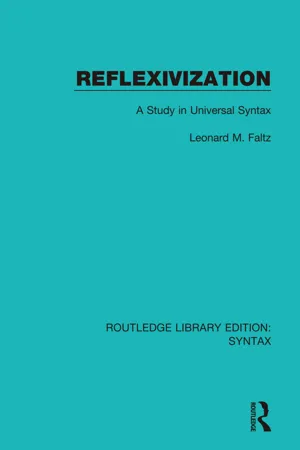Languages & Linguistics
Reflexive Pronouns
Reflexive pronouns are used to refer back to the subject of the sentence. They indicate that the subject of the sentence is also the recipient of the action. In English, reflexive pronouns include words like "myself," "yourself," "himself," "herself," "itself," "ourselves," "yourselves," and "themselves." These pronouns are essential for expressing actions that are performed by and directed back to the subject.
Written by Perlego with AI-assistance
Related key terms
3 Key excerpts on "Reflexive Pronouns"
- eBook - ePub
The Self, the Lord, and the Other according to Paul and Epictetus
The Theological Significance of Reflexive Language
- Michael J. Gorman(Author)
- 2023(Publication Date)
- Cascade Books(Publisher)
3 . Syntax and Semantics of the Various Uses of the Reflexive PronounThe uses of the reflexive pronoun may be classified into four main syntactical categories: (a) objects (both direct and indirect) of verbs; (b) objects of prepositions; (c) indicators of possession; and (d) reciprocal pronouns. Several (e) minor uses of the reflexive will also be mentioned.The main semantic issue in the three most frequently used categories (a-c) is the degree of emphasis or contrast communicated by the reflexive, since reflexivity or coreference can be expressed, in each of these categories, without emphasis and by means other than the reflexive pronoun.218a. Objects of VerbsThe most common use of the reflexive pronoun in both classical and Hellenistic Greek, as in all languages with Reflexive Pronouns, is as the object (usually direct) of a verb.219 Semantically, the reflexive functions as an “affected” participant, either the patient (grammatically, direct object) or goal or benefactive (grammatically, indirect object, or dative of advantage or disadvantage).220 The nuclear structure of this kind of construction is[agent1 ] + [action] + [affected1 ]where the agent is also the affected participant.According to most Greek grammarians, when the reflexive pronoun is the object of the verb, its reference to the subject of the sentence is sometimes emphatic; that is, the occurrence of “myself” as the direct object of a Greek verb may imply “I mean me, not you or him.”221 As mentioned in the general discussion of reflexivization,222 however, it is incorrect to assume that the reflexive pronoun as a verbal object implies emphasis on the pronoun, even if at times it actually does convey emphasis. Such an assumption is incorrect because Reflexive Pronouns are so common and are usually syntactically determined (“obligatory”) in Greek as in most other languages. Schwyzer correctly notes that context determines whether a reflexive object is emphatic, demonstrating with examples that a reflexive is most clearly emphatic when it is explicitly contrasted with another noun or pronoun.223 - eBook - ePub
Reflexivization
A Study in Universal Syntax
- Leonard M. Faltz(Author)
- 2016(Publication Date)
- Routledge(Publisher)
(12) was interpreted as signalling a reflexive context, is in fact a reflexive pronoun?My approach will be to give an archetypical reflexive context which can be examined in any language. This context will provide the starting point for deciding what grammatical devices will be considered reflexives in the language in question.Specifically, I assume that, given any language, we can isolate a class of simple clauses expressing a two-argument predication, the arguments being a human agent or experiencer on the one hand and a patient on the other. Such clauses will consist of a verb, denoting the predicate, two noun phrases, referring to the arguments, and any tense-aspect, modal, agreement, or other grammatical material required by the syntax. (Of course, one or both of the noun phrases may be reduced to a pronoun or deleted entirely (depending on the language) if the reference is anaphoric, deictic, or unspecified.) Now, if the language has a grammatical device which specifically indicates that the agent/experiencer and the patient in such clauses are in fact the same referent,1 then that grammatical device will he called the primary reflexive strategy of that language.Let us take English as a straightforward example, and, to keep things simple, consider only clauses with the main verb see , such as:The subject and object noun phrases2 are coreferent if and only if the object noun phrase consists of one of the words myself , ourselves , yourself , yourselves , himself , herself , itself , oneself , or themselves . In traditional transformational grammar this has been described by saying that a rule of reflexivization changes the object noun phrase into the appropriate reflexive pronoun if it is coreferent with the subject.3 - Luis H. González(Author)
- 2022(Publication Date)
- Routledge(Publisher)
The difficulty comes from a grammar based on grammatical relations (subject, direct object, indirect object), which has made it extremely difficult to see that the GRAMMATICAL subject of a coreference reflexive sentence (a “true” reflexive or a “regular” reflexive) is actually the underlying (LOGICAL) verbed or verbee. The explanation of reflexive constructions based on grammatical relations has resulted in the need to posit multiple functions of se, so difficult to tell apart that even scholars cannot agree on them. A grammar based on verber, verbed, and verbee accounts with a single rule for all of the sentences with an intransitivizing pronoun discussed in this book: an intransitivizing pronoun shows that the verber of the sentence was replaced. Therefore, this analysis shows that the subject of a coreference reflexive sentence is the verbed, which has been unaccusativized (promoted from the accusative or direct object position to the subject position); or the verbee, which has been undativized (promoted from dative or indirect object position to subject position). An intransitivizing pronoun that replaces the verber also explains decausative sentences (la puerta se abrió ‘the door opened’, el vaso se quebró ‘the glass broke’). This analysis also shows that the subject of a causative sentence with a reflexive pronoun as in Rosa se cortó el pelo ‘ Rosa had her hair cut’ because a hair stylist cut her hair (i.e., cut her hair for her) is the underlying verbee, uncontroversial evidence that an intransitivizing pronoun replaces the underlying verber (the hair stylist)
Index pages curate the most relevant extracts from our library of academic textbooks. They’ve been created using an in-house natural language model (NLM), each adding context and meaning to key research topics.


